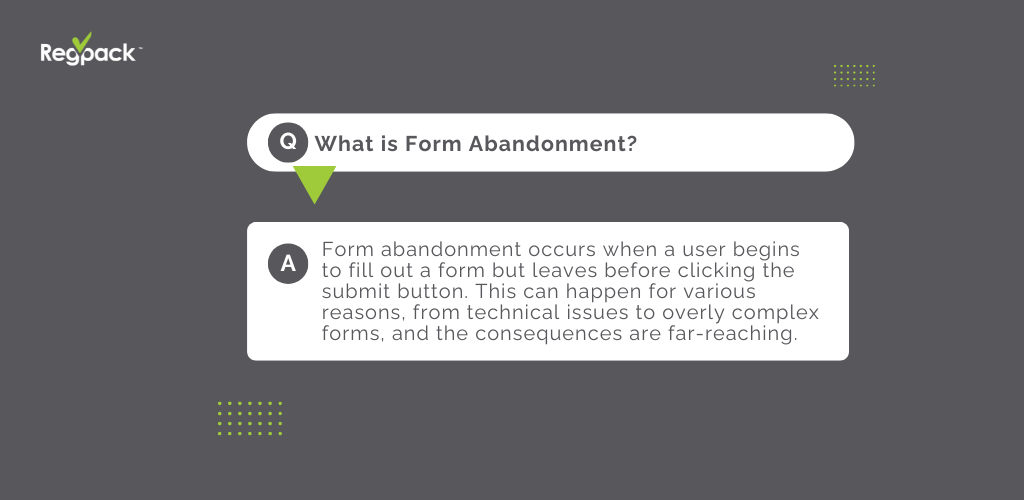Did you know that a large portion of online forms are abandoned before completion? That’s a staggering statistic that highlights just how crucial it is to understand and address form abandonment. For businesses, every abandoned form represents a potential lost customer, a missed revenue opportunity, and wasted resources.
Let’s discuss tracking form abandonment, helping you pinpoint issues and improve your conversion rate. Whether you’re running registration forms, donation forms, or checkout forms, understanding where and why site visitors drop off is the first step toward turning lost opportunities into actionable wins.
What is Form Abandonment & Why It Matters

Form abandonment occurs when a user begins to fill out a form but leaves before clicking the submit button. This can happen for various reasons, from technical issues to overly complex forms, and we want to address this so our users can have an enjoyable experience!
Why Addressing Form Abandonment is Critical
- Missed Opportunities: Every abandoned form could have been a new user account, a donation, or a sale.
- Revenue Loss: For e-commerce and SaaS businesses, high form abandonment rates equate to thousands of dollars in lost income.
- Wasted Ad Spend: You’ve paid to drive site visitors to your form through advertising, only to see them leave without converting.
By tracking user behavior and understanding the root causes of abandonment, you can boost your conversion rates, increase ROI, and provide a seamless experience for your potential customers.
Common Causes of Form Abandonment
Understanding why users abandon forms is key to solving the problem. Here are the most common culprits:
Form Length
- Problem: Long forms with too many fields or unnecessary questions overwhelm users.
- Solution: Simplify the form by focusing only on the most essential information.
Complexity
- Problem: Poor form design or confusing multi-page forms discourage completion.
- Solution: Optimize the design with clear instructions and a progress bar for multi-page forms.
Technical Issues
- Problem: Forms that don’t work well on different devices or outdated browsers like Internet Explorer can frustrate users.
- Solution: Ensure your forms are mobile-optimized and browser-compatible.
Security Concerns
- Problem: Users hesitate to provide personal information without visible trust badges or assurances of data protection.
- Solution: Add SSL certificates Add SSL certificates and privacy policy links to instill trust.
Form Field Errors
- Problem: Lack of inline validation leads to errors going unnoticed until submission, frustrating users.
- Solution: Provide real-time error feedback to improve the user experience.
How to Track Form Abandonment Effectively
Form abandonment tracking involves monitoring user behavior to identify where users drop off during the form-filling process. By understanding these patterns, you can make targeted improvements to enhance the completion rate.
Tools to Use
#1 Google Analytics
- Set up custom HTML tags and use Google Tag Manager to track user interactions, such as when a user clicks on a form field or exits the form entirely.
- Example: Use event tracking to monitor specific drop-off points in application forms or checkout forms.
#2 RegPack’s Built-In Analytics
- With RegPack, you can track partial entries, analyze trends in user interaction, and uncover areas for optimization in real time.
Metrics to Monitor
- Completion Rate: What percentage of your site visitors complete the form?
- Drop-Off Points: Where do users abandon forms? Identify these areas in contact forms, donation forms, and beyond.
- Abandonment Rate: Calculate the total percentage of forms started but not submitted.
Best Practices to Reduce Form Abandonment
Once you’ve identified the issues, it’s time to implement solutions. Here are some best practices to reduce form abandonment:
1. Simplify Forms
- Reduce the number of fields and remove unnecessary questions.
- Example: Instead of asking for a phone number in every scenario, make it optional.
2. Optimize for Mobile
- Ensure forms work seamlessly on different devices.
- Tip: Use responsive design and larger clickable elements for mobile users.
3. Test Your Forms
- Conduct A/B tests to optimize elements like the submit button, layout, and field labels.
- Example: Test whether “Submit” or “Get Started” resonates more with users.
4. Build Trust
- Add trust badges and clear privacy disclaimers to alleviate security concerns.
5. Use Inline Validation
- Provide instant feedback when a field is filled incorrectly, enhancing the user experience.
How RegPack Helps Solve Form Abandonment
RegPack helps businesses worldwide automate their registration and workflows with certain tools in place to help businesses combat form abandonment and improve their conversion rates:
RegPack’s Core Features
- Customizable and Responsive Form Design
- Create web forms tailored to your industry with intuitive designs and mobile-friendly layouts.
- Real-Time Analytics
- Monitor form data, track partial entry, and precisely identify problem areas.
- Built-In Lead Generation Tools
- Automated follow-up emails for incomplete submissions keep users engaged and improve completion rates.
Real Results with RegPack

RegPack’s solutions are designed to help businesses minimize form abandonment and optimize their workflows, delivering measurable improvements. While results may vary depending on the specific use case, businesses using RegPack often see:
- Improved Completion Rates: By simplifying the form-filling process and using features like inline validation and conditional logic, many organizations reduce drop-off rates significantly.
- Enhanced User Experience: Mobile-optimized forms and clear navigation improve engagement for users across different devices.
- Higher Conversion Rates: Automated follow-ups for partial entries encourage users to return and complete their forms, turning potential losses into conversions.
- Streamlined Workflows: Customizable and responsive form designs help businesses save time and resources, focusing on what matters most—serving their customers.
These outcomes are achievable by following form design best practices and leveraging RegPack’s advanced tools to track, analyze, and optimize user behavior throughout the registration process
Stop Losing Leads: Take Control of Form Abandonment Today
Form abandonment is a common challenge, but it’s one that businesses can overcome by understanding user behavior, implementing best practices like simplifying form design and improving mobile usability, and using advanced tools like RegPack, you can turn lost opportunities into valuable conversions. Tracking form abandonment isn’t just about identifying problems—it’s about taking proactive steps to enhance the user experience, increase completion rates, and ultimately boost your conversion rate. Addressing form abandonment is an investment in your business’s growth and success.
Don’t let something as simple as an inefficient form hurt your business. Eliminate form abandonment and maximize your results by scheduling a demo with RegPack today and see how a well-designed, optimized form can make all the difference between a lost potential customer and a satisfied user ready to take the next step.


















